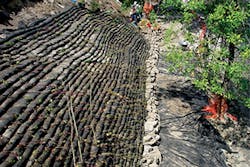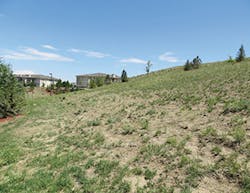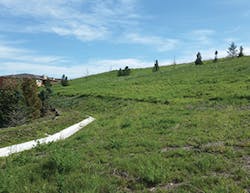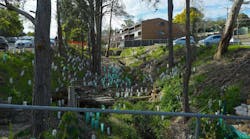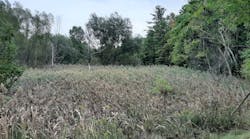Editor’s note: This article first appeared in the May 2016 issue of Erosion Control.
In revegetation, everything begins with the soil—usually poor soil.
Soils may become degraded during the construction of buildings, roadside projects, or mining or landfill operations, or because of overgrazing or deforestation. They lose their topsoil, usually the top 2- to 8-inch layer of the soil, where the most important nutrients lie. In addition to sand, stone, and clay, topsoil contains decayed plant and animal matter, bacteria, fungi, algae, insects, earthworms, and nematodes.
This is where plants generally concentrate their roots, which reach out and stabilize the soil. When the plants and their roots are removed, especially on slopes, the topsoil is the first thing to erode.
The subsoils are inferior. Sandy soils contain so much air between the particles that any microbes in the soil consume organic matter very quickly. Without organic matter, soil particles don’t stick together and form crumb structures, and water drains into the subsoil too quickly.
Compacted and clay soils contain so little air that they are generally low in both organic matter and microbes. Plant roots become stunted because it is too hard for them to push their way through the soil. Because water drains through them slowly, it can completely fill the pore spaces, waterlogging the soil.
Acidic and alkaline soils prevent nutrients such as nitrogen, phosphorus, potassium, iron, zinc, copper, and manganese from dissolving in water. As a result, nutrients can’t be readily absorbed by plants’ roots.
Soils may be contaminated by chemicals, stripped of nutrients by overtillage and inadequate soil management, or salinated by irrigation water. Degraded land often absorbs less water, which can cause or worsen flooding.
All soil problems can be improved by various methods to varying degrees.
Incorporating compost—the partially decomposed remains of soil organisms and plant life—helps replace the topsoil. Compost buffers the soil, which neutralizes both acid and alkaline soils. It improves soil structure by binding clusters of soil particles, called aggregates, and making the soil less likely to erode. These aggregates have both large and small pore spaces, which moderate the flows of air and water and slow down the consumption of the organic matter by the organisms in the soil.
Compost contains macro- and micronutrients that feed the organisms in the soil, such as bacteria, fungi, nematodes, insects, and earthworms, which keep the soil well-aerated. The excretions from these organisms convert organic matter and soil minerals into vitamins, hormones, and nutrients that plants need to grow. The excretions improve the soil structure as well.
Mulch is a layer of a material on top of the soil. It can be organic, such as wood chips, straw, and even compost, or inorganic, such as stones, brick chips, and plastic. It may include soil amendments and/or seed. It can be applied manually, by blower truck, and by hydroseeding equipment. Mulch protects the soil from erosion, reduces compaction from heavy rains, conserves moisture, moderates the soil temperature, and prevents weed growth. As organic mulches decompose, they provide organic matter to the soil, which improves root growth, increases water infiltration, and improves the water-holding capacity of the soil.
When soils are unhealthy, not simply poor, soil amendments provide additional help. Some soil amendments are simple. They include sphagnum peat moss, lime, sulfur, gypsum, and builder’s sand.
The slope before the 2014 revegetation
On the other hand, some soil amendments are ingenious and hi-tech. For example, BioSol, from Rocky Mountain Bio Products in Denver, CO, is a byproduct of the manufacture of penicillin. When raw materials such as soybean meal, cottonseed meal, sucrose, lactose, trace elements, and vitamins are fermented under constant sterile conditions, they produce a fungal mass, or mycelium. The penicillin is extracted and the remaining mycelium is dried and granulated, and sold as BioSol.
The high organic content in BioSol stimulates root development and microorganisms, such as bacteria, which provide quality micro- and macronutrients for plants. In addition, because some of the bacteria fix, or convert, nitrogen into compounds that are available to plants, the risk of nitrate leaching is very low.
The Parker slope after project completion
Mycorrhizae, which Rocky Mountain supplies as well, improve plants’ ability to absorb water and nutrients from the soil, enhance their health and vigor, and increase their resistance to stress and diseases. They also improve the phytoremediation of sites contaminated by petroleum and heavy metal, according to Texas A&M University.
PermaMatrix, from Sunmark Environmental and Sunmark Seeds in Portland, OR, contains biochar, organics, micro-organisms, beneficial fungi, water-holding materials, and many other soil-like components.
Biochar is a charcoal used as a soil amendment. It’s a product of pyrolysis, which occurs when biomass such as crop residues, nut shells, fruit pits, animal manures, and yard, food, and forestry wastes, decompose at the temperature of 550°C in the absence of oxygen. Because there’s no oxygen, the biomass doesn’t combust. Instead, the chemical compounds that make it up thermally decompose into combustible gases and charcoal, according to the USDA Agricultural Research Service.
Biochar does not decompose with time. It provides nutrients, increases water absorption, and minimizes the leaching of nutrients into the groundwater. It improves the physical and chemical properties of the soil and provides bioremediation by absorbing contaminants, including inorganic and organic pollutants, which improves water quality. It also helps with carbon sequestration, or long-term storage, in the soil.
Once the soil has been amended, it’s ready for planting. The seed is crucial to the success of any revegetation project.
For hundreds of years, immigrants, beginning with the first settlers in the United States, brought seeds with them from their homelands. They planted them as they moved westward across the country, for food crops, livestock forage, windbreaks, landscaping, and medicine.
They also used the seeds to control erosion. Many of the introduced seeds were readily available, inexpensive, fast growing, and aggressive—exactly what was needed for quick and effective revegetation. These introduced species spread virtually uncontrolled and have been causing major environmental problems across the country. They outcompete native species for water, light, and soil nutrients, which degrades the habitat, causing the loss of biodiversity and native ecosystems. On farmland, they can injure or kill livestock. They also increase the risk of wildfires.
Ironically, they can also result in erosion, which causes the loss of
To continue reading the full article, which includes additional case studies and in-depth reporting, check out the May edition of Erosion Control. Please click here. You may need to log-in or subscribe to our magazine.